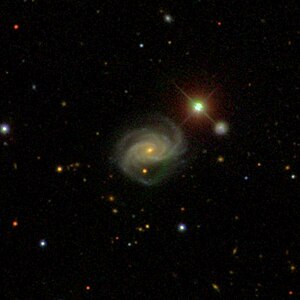NGC 2840
| Galaxy NGC 2840 |
|
|---|---|

|
|
| NGC 2840 & 2MASX J09204805 + 3522239 , SDSS | |
| AladinLite | |
| Constellation | lynx |
|
Position equinox : J2000.0 , epoch : J2000.0 |
|
| Right ascension | 09 h 20 m 52.7 s |
| declination | + 35 ° 22 ′ 06 ″ |
| Appearance | |
| Morphological type | SB (rs) bc / LINER |
| Brightness (visual) | 13.8 mag |
| Brightness (B-band) | 14.6 mag |
| Angular expansion | 1 ′ × 0.9 ′ |
| Position angle | 110 ° |
| Surface brightness | 13.5 mag / arcmin² |
| Physical data | |
| Redshift | 0.025017 +/- 0.000007 |
| Radial velocity | 7500 +/- 2 km / s |
|
Stroke distance v rad / H 0 |
(334 ± 23) x 10 6 ly (102.4 ± 7.2) Mpc |
| history | |
| discovery | William Herschel |
| Discovery date | March 10, 1790 |
| Catalog names | |
| NGC 2840 • UGC 4960 • PGC 26445 • CGCG 181-032 • MCG + 06-21-025 • IRAS 9178 + 3534 • 2MASX J09205267 + 3522062 • GC 1822 • H III 827 • h 586 • | |
NGC 2840 is a bar-spiral galaxy with an active nucleus of the Hubble-type SBbc in the constellation of the lynx in the northern sky . It is an estimated 334 million light years away from the Milky Way and has a diameter of about 95,000 ly.
In the same area of the sky are the galaxies IC 2456 and IC 2459 .
The object was discovered on March 10, 1790 by William Herschel .
